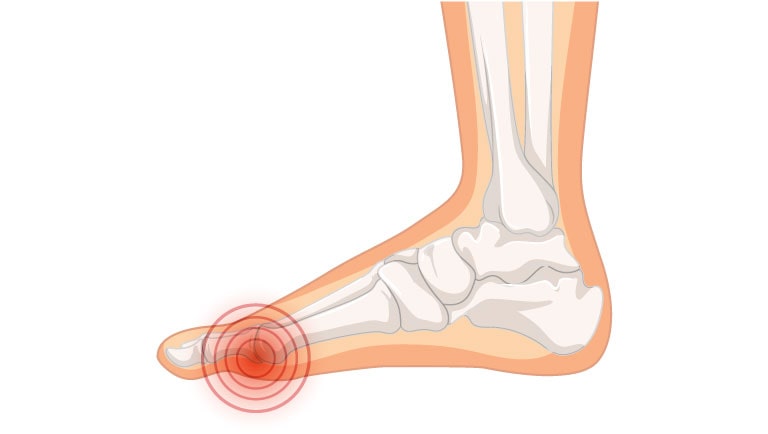Hallux Valgus (Bunions): Risk Factors, Diagnosis, and Treatment
Hallux Valgus: What is it?
Hallux valgus is a deformity affecting the first metatarsal.
The first metatarsal deviates in varus, causing valgus of the proximal and distal phalanges.
In the most pronounced deformities, the valgus of the first metatarsal can compromise and alter the normal anatomy of the entire forefoot, causing adjacent toes to crowd together due to lack of space, or in even more severe cases, the second toe overlapping the big toe.
This subversion of the forefoot anatomy therefore leads to an alteration in biomechanics and consequently gait.
However, hallux valgus is not just a skeletal deformity.
In fact, soft tissue involvement is typical; consider the formation of what is known as a "bunion" caused by the friction of the bone with the surrounding soft tissues.
This can reach such a degree of inflammation (bursitis) that it ulcerates with a consequent risk of infection.
It is therefore important, even if we are not talking about a pathology that represents an emergency, to keep the deformity under control and undergo specialized evaluation not only if the pain becomes significant, but also in cases where the deformity is rapidly progressing.

Hallux Valgus: Risk Factors
There is certainly a strong family history in the development of this pathology. It is easy to see how many patients have ancestors and relatives in their family presenting with the same deformity. The use of incongruous footwear, such as narrow shoes, is certainly not among the causes of hallux valgus. On the contrary, it can be stated that a narrow shoe, which keeps the anterior arch compressed, may even slow the onset of the deformity, which is characterized precisely by the fan-like widening of the anterior arch.
Just like eye color or hand structure, the shape of the foot and toes is already determined at birth. This also applies to the shapes that the foot and toes will take at different stages of our lives. Hallux valgus is therefore a true anatomical variant of the foot, just like flat feet or high arches.
In summary, the most frequent causes that can lead to the development of a hallux valgus are:
- Congenital malformations or genetic predisposition;
- Foot injuries and fractures;
- Overweight and obesity;
- Poor posture;
- Arthritis;
- Prolonged use of shoes with narrow soles and toes and very high heels;
Hallux Valgus: Symptoms
In the foot, there is misalignment and wear of the cartilage, which degenerates into osteoarthritis over time and hallux valgus pain.
The main symptoms are intense pain: the inflammation of the cartilage and the rubbing of the prominence against shoes at the metatarsal head prevent the patient from wearing normal shoes.
Over time, the deformity can worsen and dislocations of the forefoot joints can occur: the push of the big toe against the other toes causes them to bend dorsally until they become deformed (hammer toes) and in more advanced cases, there is a loss of contact of the articular surfaces (dislocation) between the phalanges and between the metatarsal head and the base of the proximal phalanx.
Hallux valgus also has serious consequences on the patient's posture, as it causes inward rotation of the foot during walking (pronation), which alters the mechanical axis of the lower limbs and spine. This postural configuration creates articular inconsistencies, to the point that we speak of "hallux valgus postural syndrome".
EXPRESS QUOTE
Would you like more information?
Your health, our priority.
Request your free quote
Hallux Valgus: Diagnosis
To diagnose hallux valgus, the specialist performs a simple physical examination, through which he can also check the ability of the toes to move. It may then be useful to perform a radiographic examination of the foot, in order to clearly observe the internal situation and the evolution of the dysfunction.
Hallux Valgus: Treatment
In the early stages, hallux valgus can be treated with so-called conservative therapy, which, it should be noted, does not cure or reverse the disorder, but only slows its progression:
- Avoid activities that require you to stand for long periods;
- Wear comfortable shoes with a wide sole and low heel (the shoe must follow the natural shape of the arch, the sole must fit comfortably to the heel, the heel should not exceed 4-5 cm);
- You can use hallux valgus orthotics to help realign the bones of the foot, which are also useful in prevention;
- You can follow physiotherapy treatments that can reduce symptoms;
- Finally, there are anti-inflammatory drugs (such as paracetamol or ibuprofen) that relieve pain and inflammation;
Beware of grandmother's remedies for hallux valgus, as they are often ineffective.
As a last resort, there is surgery, for which, of course, you must seek advice from your doctor. So it's good to ask yourself the question hallux valgus: when to operate?
The definitive treatment for hallux valgus is surgical.
Hallux valgus surgery can be of two types:
- Open surgery, i.e. the classic surgical approach, which consists of opening the skin and correcting the valgus by removing part of the bone and inserting supports that maintain the bone and cartilage structures in the correct positions. Hallux valgus surgery is effective but recovery times are quite long;
- Percutaneous surgery, which consists of fluoroscopy, i.e. intervention on the bone through small holes in the skin. This approach is less invasive and recovery times are shorter;
It is the orthopedic surgeon who assesses the most appropriate treatment, depending on the extent of the valgus, the pain load, and any other related dysfunction.